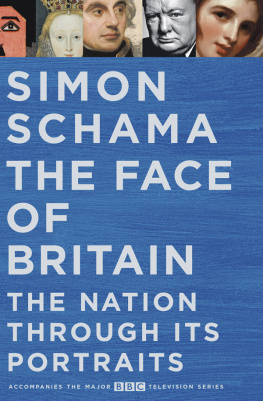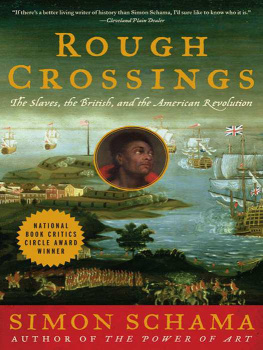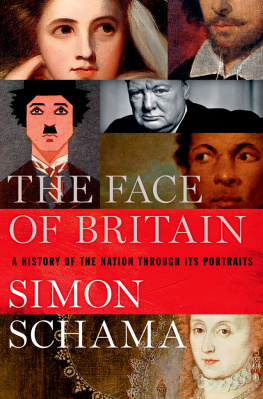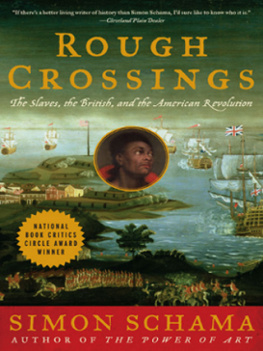Contents
Simon Schama
THE FACE OF BRITAIN
The Nation through Its Portraits
VIKING
UK | USA | Canada | Ireland | Australia
India | New Zealand |South Africa
Viking is part of the Penguin Random House group of companies whose addresses can be found at global.penguinrandomhouse.com
First published 2015
Text copyright Simon Schama, 2015
Images copyright National Portrait Gallery, London, 2015,
unless otherwise stated on pages 54761
BBC and the BBC logo are trade marks of the British Broadcasting Corporation and are used under licence. Logo BBC 1996.
Author image: Howard Sooley
The moral right of the copyright holders has been asserted
The : Written by John Lennon Lenono Music. Used by permission. While every effort has been made to contact copyright holders, the publishers will be happy to correct any errors of omission or commission brought to their attention
ISBN: 978-0-241-96371-5
THE BEGINNING
Let the conversation begin...
Follow the Penguin Twitter.com@penguinukbooks
Keep up-to-date with all our stories YouTube.com/penguinbooks
Pin Penguin Books to your Pinterest
Like Penguin Books on Facebook.com/penguinbooks
Listen to Penguin at SoundCloud.com/penguin-books
Find out more about the author and
discover more stories like this at Penguin.co.uk
By the same author
FICTION
Dead Certainties: Unwarranted Speculations
NON-FICTION
Patriots and Liberators: Revolution in the Netherlands, 1780 1813
Two Rothschilds and the Land of Israel
The Embarrassment of Riches: An Interpretation of Dutch Culture in the Golden Age
Citizens: A Chronicle of the French Revolution
Landscape and Memory
Rembrandts Eyes
A History of Britain, Volume I: At the Edge of the World? 3500 BC 1603 AD
A History of Britain, Volume II: The British Wars, 1603 1776
A History of Britain, Volume III: The Fate of Empire, 1776 2000
Hang-ups: Essays on Painting (mostly)
Rough Crossings: Britain, the Slaves and the American Revolution
The Power of Art
The American Future: A History
Scribble, Scribble, Scribble: Writing on Politics, Ice Cream, Churchill and My Mother
The Story of the Jews: Finding the Words, 1000 BCE 1492 CE
For Jan Dalley
in love and friendship
Is not the face given to vision?
Emmanuel Levinas, Sensibility and the Face,
in Totality and Infinity
1. The Look
You spend a little time in front of a portrait and then you move on. But you have the odd feeling that the eyes of that painted face are tracking you round the gallery. Its a clich, a joke, a fable, the kind of thing that has the guards rolling their eyes. But you are not altogether deluded. From somewhere deep in the temporal cortex of your brain has come, unbidden, the act which made you human in the first place: the locking of eyes.
Trust an artist to spot the one item of our anatomy which, our whole life long, never changes size. In his Analysis of Beauty William Hogarth noticed that though every feature grows larger and longer till the whole person has done growing, the sight of the eye still keeps its original size; I mean the pupil, with its iris or ring; for the diameter of this circle continues still the same You may sometimes find this part of the eye in a new-born infant full as large as in a man of six foot, nay sometimes larger.
He was right. We come into the world wide-eyed, ready to stare. And after we are done crying, eyes scrunched tight against the raw light, we start looking, which is the precise moment we begin to live in the company of humans. Nonsense, I was told; newborns cant see a thing; blind as a bat. Takes days, weeks, to make out anything. But I knew better.
A grim rain was falling on Boston in the early hours of 15 May 1983. The soundtrack for the birth of my daughter was Vivaldi and typewriter; a natural combo. No hospital staff wrote reports on computers at that time; every Caesarean section had to be documented. Vivaldi was the obstetricians idea. As my wife was wheeled into the ward, up bounced the Jerry Garcia of obstetrics: flower shirt; jeans distressed but not as much as me. First words out of Jerrys mouth were: Music, man [I swear]; you brought music, right? Gotta have it. Whatll it be? Not Sugar Magnolia, sunshine, I thought; and definitely not Truckin. Embarrassed even as the word left my mouth, I went lofty on him. Schubert? Jerrys brow furrowed. We got Vivaldi, I think. And typewriter.
But we also got daughter. Around 2 a.m., the rain hammering down on Brookline Avenue, a girl was lifted from the pond of blood, howling on cue, wiped clean of vernix and set in my trembling arms.
She stopped crying. A heavy sleep descended. But then after no more than ten minutes and possibly less, she opened her eyes, unnaturally enormous in a smooth, open face, unbruised by any jolting passage through the birth canal. Those pupils were fully operational, the irises a startling cobalt. We looked at each other through clouded vision mine occluded with tears; hers doing the best it could with neonate optical musculature giving each other the once-over. So much for the received wisdom. I knew my daughter was staring at me, and with an intensity that made it feel like a mute interview for fatherhood. She looked worried; we exchanged anxieties. I was not confident I had got the job. But I was sure we had made a connection; so sure that I moved my head a little to the right. Which is when it happened: the ocean-dark eyes with their big, black pupils followed the movement of my head. I took the experiment further, extending the range of my head movement; right and left, two or three times in each direction. Every time the babys eyes tracked mine. This is not what one has been told, I said to myself. But this is undeniably happening. We were face to face. Hiya, darling.
Thirty years on, science has no doubts. The first thing newborns do, if all is well, is howl. Who can blame them? Its a rough ride. But when they open their eyes, they can make out, albeit in blurred forms, the bits of a face that count: eyes, nose, mouth, hairline; the contours of the head. Their engagement with that face is immediate and intense; the strong contrasts between light and shade help. Very quickly the attraction fastens to more than those contrasts. Presented with pictures of scrambled features or an upside-down face, the baby of but a few weeks loses interest, already deciding that this jumble of lines and shapes is somehow an unimportant distraction. A face with closed eyes will also leave her cold. Humans are the only primates to have so large an area of white sclera surrounding the darker iris and pupil, and this helps to attract the attention of the infant. Eyebrow movement animates and frames this mutual gaze. It is all that the baby wants to see.
















